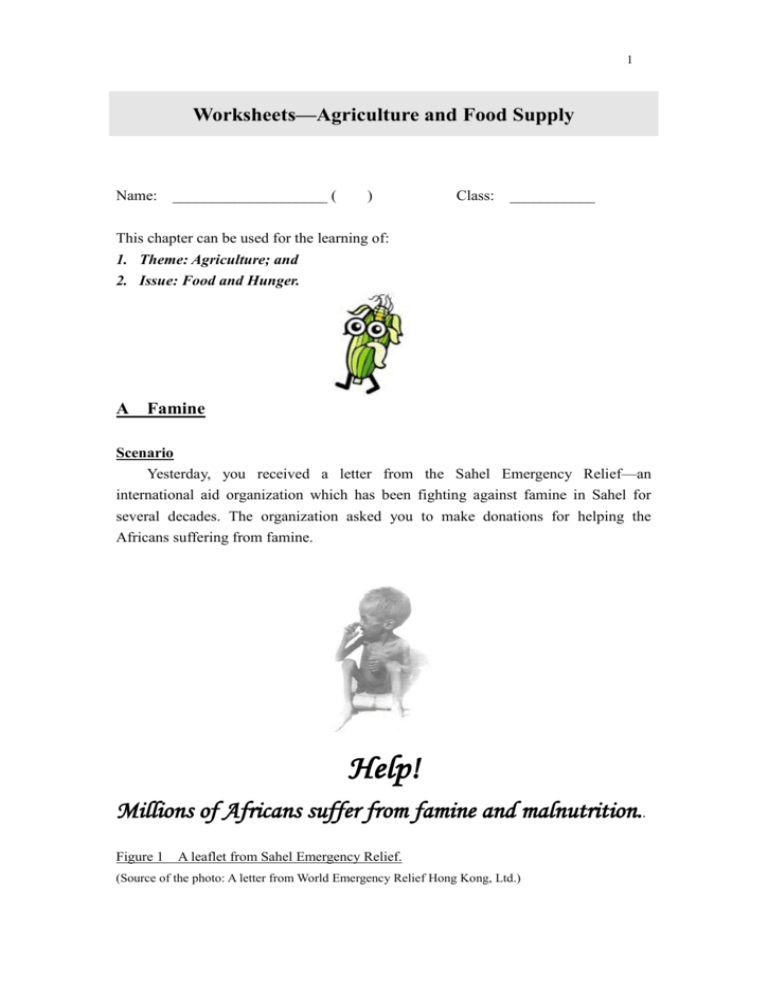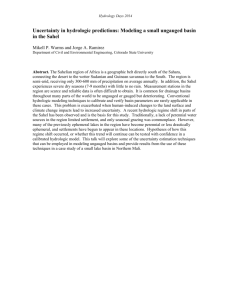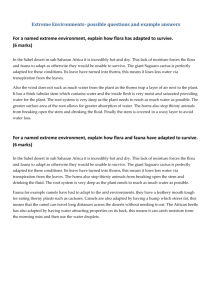Worksheets—Agriculture and food supply
advertisement

1 Worksheets—Agriculture and Food Supply Name: ____________________ ( ) Class: ___________ This chapter can be used for the learning of: 1. Theme: Agriculture; and 2. Issue: Food and Hunger. A Famine Scenario Yesterday, you received a letter from the Sahel Emergency Relief—an international aid organization which has been fighting against famine in Sahel for several decades. The organization asked you to make donations for helping the Africans suffering from famine. Help! Millions of Africans suffer from famine and malnutrition.. Figure 1 A leaflet from Sahel Emergency Relief. (Source of the photo: A letter from World Emergency Relief Hong Kong, Ltd.) 2 1. In the leaflet (Figure 1), you see a poor African in Sahel. He is very hungry and sad. You want to know where is Sahel. Refer to Map 1 which marks the major African countries in Sahel (a-g). Write the names of these countries in the spaces below the map. Map 1 African countries mainly located in Sahel. a. e. b. f. c. g. d. 2. With the help of an atlas, shade the area of the Sahara Desert on Map 1 in light brown. 3 3. Browse the following website, go to ‘Part I The Sahel, 1. Geographical Overview’ of the website and answer the questions below. Website — Survival in the Sahel http://www.isnar.cgiar.org/publications/books/sahel/english/intro.htm a) On Map 1, shade the area of Sahel in yellow. b) Use an atlas to find out the climatic characteristics of the Sahel countries. 4. Describe the level of economic development of the Sahel countries. Scenario In order to examine the factors affecting famine in Africa, you choose Ethiopia as a case study. You have found some information from the Internet about famine in Ethiopia. 4 5. Famine: a natural or human-induced disaster? — A case study of Ethiopia a) Visit the following website about the climate, food and agriculture of Ethiopia. (FAO/GIEWS)—Food and Agriculture in Ethiopia http://www.fao.org/WAICENT/faoinfo/economic/giews/english/basedocs/eth/ethtoc1e.htm b) Then, refer to the following parts of the website and answer the questions below. Give evidence to support your answers. ‘Current Agricultural Situation’; ‘Previous Agricultural Situation’; ‘Information on Food Consumption’; ‘Administrative Map’; ‘Meteorological Profile’; ‘Crop Zones’; ‘Crop Calendar’; and ‘Population’ i) Describe the climate of Ethiopia. ii) Describe the characteristics of agriculture in Ethiopia. 5 iii) What are the relationships between the characteristics of agriculture and the climate in Ethiopia? More information about the climate of Ethiopia can be found in the following website: World Travel Guide – Ethiopia – Climate http://www.travel-guide.com/data/eth/eth500.asp c) Causes of famines in Ethiopia in the past several decades. i) According to the information in the following website, fill in the missing information in Table 2. Deforestation is Fuelling Environmental Deterioration and Famine in Ethiopia http://www.etff.org/dec1205deforstation.htm 6 Causes 1. Climate and drought Notes Abnormal rainfall patterns and amounts can be found in Ethiopia in some years. 2. Debt Ethiopia has heavy debt, so its government does not have money to improve its agricultural sector. Advanced facilities cannot be introduced to fight against droughts. 3. Deforestation and its effects 4. War About one million people were killed in the 1984 famine of Ethiopia. This famine happened after the occurrence of wars at different parts of Ethiopia, such as war with Eritrea. Since the late 1990s, Ethiopia has attacked Eritrea repeatedly. 5. Type of agricultural activity War will cause the depletion of resources for future use. Ethiopia is heavily dependent on rain-fed agriculture. Abnormal rainfall patterns and amounts in some years may then cause serious famines. 6. Fire Massive fires in Ethiopia destroyed large amount of forests. 7. Poor facilities to conserve Ethiopia lacks facilities to conserve rainwater, so rainwater rainwater Table 2 cannot be conserved for future use or in times of drought. Causes of famines in Ethiopia. 7 ii) Briefly summarize the causes of famines in Ethiopia in the past decades. Classify the causes into 2 groups—‘natural’ and ‘human-induced’. iii) Do you think famines in Ethiopia belong to natural or human-induced disaster? Give reasons. If you have difficulties in answering the above question, you may find useful information in the following website: Uprooting the Root Causes of Famine in Ethiopia http://dekialula.com/articles/dr_g_araia5.html 8 B The Agricultural Systems of Sahel and Southern California Scenario In order to know more about famine in Sahel, you decide to investigate the agricultural system and food supply there. Moreover, the agricultural system in Southern California is chosen for comparison with that of Sahel. 1. What is an agricultural system? When we talk about the main components of an agricultural system, we usually refer to the simple input-output model below: 9 2. Developing an input-output model for an agricultural system Nomadic herding is one of the most common agricultural practices in Sahel. The following is an illustration of how to develop an input-output model for nomadic herding as an agricultural system. a) Inputs of a nomadic herding system in Sahel The inputs of an agricultural system can be divided into two parts—‘physical inputs’ and ‘human inputs’. Physical inputs include items such as ‘climate’, ‘relief’ and ‘soil’. For human inputs, ‘labour’, ‘capital’, ‘technology’ ‘market’ and ‘transport’ are examples. With the help of the information on P.13-14 (the resource sheets), describe the major physical and human inputs of a nomadic herding system in Sahel by completing the boxes below. Physical Inputs 1. Human Inputs Climate: 1. Labour: 2. Capital: 3. Technology: 2. Land and soil: 4. Others: 10 b) Processes of a nomadic herding system in Sahel The ‘processes’ of a farming system refer to the farming practices and methods carried by the farmer in his farm. They are the ways in which the farmer manipulate the environment (both physical and human) and are the result of the interaction of all the physical and human inputs drawn into the farming system. Find out what kind(s) of farming practices and methods are being carried out in a nomadic herding system in Sahel and put them in the box below. Processes c) Outputs of a nomadic herding system in Sahel The main outputs of a farm system are the farm products. In addition to farm products, outputs of a farm system can also include cash (gained from selling the products) and some unwanted substances, e.g. wastes and pollutants. Some outputs of a nomadic herding system in Sahel are shown below. Try to add in a few more in the space provided. Then, for each of the outputs, classify their nature by using ‘+’ for ‘positive outputs’ and / or ‘-’ for ‘negative outputs.’ Outputs Meat and milk from animals, such as goats, sheep and cows Cash (from the sale of animals) Wastes from animals 11 12 d) Feedbacks of a nomadic herding system in Sahel Some outputs of an agricultural system may go back to the system as inputs again. These are feedbacks. According to the information in c) above, name and classify the feedbacks of a nomadic herding system in Sahel into 2 categories—‘positive feedback’ and ‘negative feedback’. Feedback Positive: Negative: 13 Now, according to the input-output agricultural system model in Part B1 (P.8), put all the parts of the nomadic herding system in Sahel (a to d above) together and link them up with arrows to show the transfer and interactions between different parts. By doing this, you are actually constructing an input-output model of a nomadic herding farming system. Figure 2 A farming system of nomadic herding in Sahel. 14 ******************************************************************** Resource sheets about Nomadic Herding in Sahel 1. Extracts of articles about the practice of nomadic herding in Sahel The practice of traditional nomadic herding in Sahel With various physical and human inputs, camels, goats, sheep and cows are kept by nomadic herdsmen in Sahel. Mixed herd in this way may use the land more efficiently as different species eat different kinds of vegetation. The herdsmen have irregular routes in Sahel to take advantages of pastures in different areas. In other words, they have no permanent homes. When the animals have eaten the vegetation in a place, the herdsmen’s families will move to a new area according to their past experience. Changes related to nomadic herding in Sahel. Traditionally, nomadic herders followed irregular routes in Sahel to allow pastures to re-growth. However, with the changes below, the re-growth of pastures and the practice of nomadic herding become more difficult. The population growth rate here is high. We need to keep more animals. Herd size represents our wealth. Keeping more animals / livestock shows that we are wealthy. It is a form of capital storing. Therefore, we keep more and more livestock. We need more animals to exchange for Nomadic herders in Sahel grains from farmers now. Because of wars, soil erosion and the Some of us are slaves in the past. However, we’re conversion of some rangelands for liberated now. We need to keep more animals for cultivation, the rangelands for our living. nomadic herding are decreasing. We must use some marginal and fragile land for grazing now. 15 2. Internet resource Survival in the Sahel http://www.isnar.cgiar.org/publications/books/sahel/english/intro.htm 3. Your geography textbook and library books will provide more details about nomadic herding in Sahel. ********************************************************************* 16 3. The Farming System of Irrigation Farming in Southern California Scenario: Southern California has similar natural environment with that of Sahel, but the farming system here and the resultant amount of food supply are very different. You will explore more about the characteristics of irrigation farming system in Southern California. a) According to what you have learnt about agricultural system in Parts B1 and B2 above, construct and draw an input-output model of the agricultural system for irrigation farming in Southern California (Figure 3 of P.16). The resource sheets on P.17-19 will give you some background information to help you complete your task. However, you need to search for extra information from the library / the Internet. 17 Figure 3 The Irrigation Farming System in Southern California. 18 ********************************************************************* Resource sheets about irrigation farming in Southern California 1. A Map of California (with the location and wind direction of Fresno) 2. A table showing the climatic characteristics of Fresno, California Type of climate in California: - Mediterranean climate (hot dry summers and warm wet winters) Temperature (Fresno): - High in summers (may above 30C) Between 5-20C from October to April (i.e. winters) every year Precipitation (Fresno): - low, about 280 mm per year - mainly in winter Evaporation rate: - high 19 3. A table showing the vital information of the characteristics of agriculture in California Number of crops: - More than 300 commercial crops are grown in California Farm size: - About 370 acres in an average However, according to the U.S. Department of Agriculture 1992 Census of Agriculture, about 80% of farms in California were less than 180 acres in farm size at that time. Type of farm: - Most farms in California are family farms Important agricultural counties in California: - e.g. Fresno and San Joaquin Functions of agricultural land: - as rangeland and for growing pasture. as cropland. Agricultural technology: - advanced level of technology Importance: California has led the nation in agricultural production for several decades. Over 50% of the nation’s vegetables, fruits and nuts are produced in California. Many agricultural products in California are for export. - 4. Internet resources about irrigation farming in California a) California Farm Water Coalition b) Fresno Valves & Castings, Inc. http://www.cfwc.com/ http://www.fresnovalves.com/index.html c) Irrigation Training and Research Centre http://www.itrc.org/index.html 20 5. A news clipping about water projects in California Water Projects in California In order to use the productive, but dry farmland in California, many water projects have been carried out to solve the problem of drought here. Of these, two of them are especially large in scale. They are ‘Central Valley Project’ and ‘State Water Project’. For the case of Central Valley Project, a lot of dams, canals, aqueducts and pumping plants were built in order to hold back the flood water (from rain and snow) of the Coast Ranges and Sierra Nevada in spring and supply water for irrigation farming in California. 6. A news clipping about irrigation technology and methods in California Irrigation Technology and Methods in California Most of the rain in California falls in winter but most crops here are not grown in that period of time. Therefore, advanced irrigation technology is needed to solve the problem. There are three main types of irrigation methods. They are ‘surface or gravity irrigation’, ‘sprinklers’ and ‘micro-irrigation’. Besides, farmers in California use computers to know more about current weather information. Some computer software programs can be used to manage irrigation in the farms. There are also laboratories to provide information on irrigation system evaluations. All these benefit irrigation farming in California. ********************************************************************* 21 4. Comparison of the agricultural systems of Sahel and Southern California According to your work in Parts B1-3 above, answer the following questions. a) Compare and contrast the outputs and resultant patterns of food supply in Sahel (nomadic herding) and Southern California (irrigation farming). Outline their differences below. b) Compare and contrast the physical and human inputs of the agricultural systems of Sahel (nomadic herding) and Southern California (irrigation farming). What are their similarities and differences? 22 c) Are the different agricultural and food supply patterns in Sahel and Southern California resulting from the variation in their farming inputs? Give reasons to support your argument. 23 Part C Negative impacts environment of agricultural technology to the Scenario: From Part B above, you know that agricultural technology may bring us benefits, e.g. stable food supply. However, it may also bring negative impacts to our environment. In this Part, you will investigate this through two case studies. 1. Case study 1 — Wells, pumping machinery and nomadic herding in Sahel Hundreds / Thousands of animals gather around the well. Zone B Zone B Zone A A well with pumping machinery Key Zone A A zone of bare soil with serious erosion Zone B A zone of grasses Figure 4 The effects of nomadic herding around a well (with pumping machinery) in Sahel. a) Refer to Figure 4, describe the practice of nomadic herding around a well here. 24 b) Describe and explain the negative effects of nomadic herding shown in Figure 4 on the natural environment. c) Suggest some measures to alleviate the negative impacts in question b) above. 2. Case Study 2 — Irrigation technology and agriculture in Southern California The sun Irrigation water (with salts) Crops/vegetation is added to the soil. Hot and dry climate leading to strong evaporation rate here. Groundwater is drawn to the surface. Key: Soil salts Figure 5 The effects of excessive irrigation on the environment of Southern California. a) What will be the soil problem shown in Figure 5? 25 b) Refer to Figure 5 and describe how salts are accumulated in the soil and outline its relationship with irrigation. c) What are the possible effects of the above soil problem on farming and food supply in Southern California? d) What can be done to alleviate this kind of soil problem? 26 Part D Donation Scenario: After knowing more about agricultural system and food supply in Sahel, refer to the leaflet from Sahel Emergency Relief again (Figure 1) and consider making a donation to the Sahel Emergency Relief. 1. Do you think we should bother about famines in other countries or regions? Why? 2. In your opinion, what is the best way for the Sahel Emergency Relief to spend the money they have collected (e.g. buying food or organizing training programmes to farmers)? Explain your choice. 27 3. What are the alternatives to the practice of giving money / food directly to the victims of famine in Africa? * Hint: The work of Oxfam may give you some ideas. Visit the website below: Oxfam Hong Kong http://www.oxfam.org.hk 4. After considering all the factors in this set of worksheets above, what is your decision about making donation to the Sahel Emergency Relief? Explain your decision.









